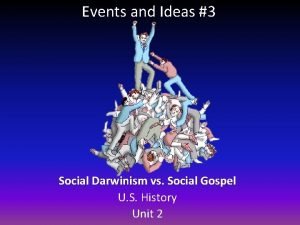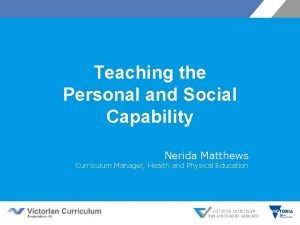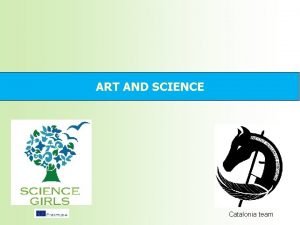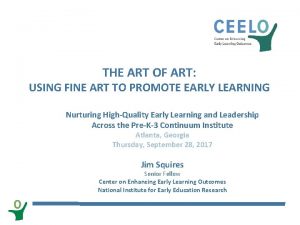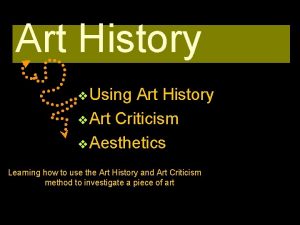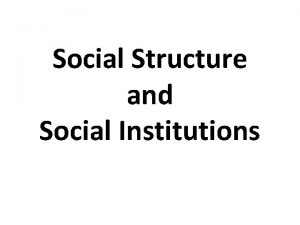Art and Social Science Assessment Using Art during














- Slides: 14

Art and Social Science Assessment

Using Art during lessons Classroom Art Activities • primary school art techniques can be used to engage students in a lesson • collage • crayon cartooning (to discourage overemphasis on detail or technique) • Colouring use to illustrate a primary school level poem, such as a cinquaine, or an acrostic Classroom Drama Activities § primary school drama techniques can be used to explore the text § scene tableaux, followed by character ‘interviews’ § quick (2 minute skit) which can be dramatically read from their desks § quick improv scenes, using set words or constraints. Many students are familiar with Improv TV shows such as ‘Who’s line is it anyway? ”

Why use Art? • • to help students to concretize, to consolidate, to explore, to personalize to give students an alternative to traditional methods of demonstration to help students to engage with the material and to maintain interest to add interest to dry (but important) subject matter Collage using various similar-coloured images to create a new picture

Accessibility • • ‘Persopolis’ by Marjane Satrapi, is a powerful work about her childhood in Iran. She uses very little shading or perspective, and works in pen and ink. • All students should be able to participate The emphasis is on expression of content and personal connection, not artistic achievement or technique Materials should be relatively cheap and accessible Techniques should be adaptable to students of varying ability, and not too technically demanding Art does not have to be technically complex to be well done, well conceived, well executed or powerful

Computer Technology • • • Photoshop techniques descend from tradition photography and collage techniques If your students have access to and are skilled with photoshop-like software, then they can certainly attempt it. However, using the actual program involves quite a bit of professional skill and can turn into an exploration of technique and medium - which is not what is required for the purposes of this course. This is a Photoshop collage using various images to ‘build’ a picture. Perspective is distorted, but shading, size and placement unify the composition.

Scrapbook techniques • • Scrapbooking is a modern folk-art, that is keeping many older techniques accessible to many Wax collage is one way to achieve a smooth layered effect Use melted beeswax (not candlewax) applied to canvas, then dress pattern tissue paper layered on top and waxed. Add paper, then wax. Run quilting iron over it. You can add crayon and found objects. Oil pastels or metal powders can be added. Black & white toner photocopies will transfer onto the wax if rubbed on. Resource: http: //www. hgtv. com/hgtv/cr_scrapbooking_ memory/article/0, 1789, HGTV_3318_374881 9, 00. html These images are from a ‘how to scrapbook’ page on the hgtv site.

Collage Techniques • • Phocopiers are readily accessible, and can be used to combine images smoothly Used in conjunction with pen and ink, charcoal, pencil, and various mixed media, a variety of effects can be achieved. This mixed media collage shows one way in which squarecut black and white images can be combined.

Collage and text • This artist uses collage journals. She makes heavy use of text, and adds images and decorative effects www. teeshamoore. com/teeshasjournal pgs. html. • • • 1 st layer - Watercolour paper 2 nd - Watercolour 3 rd - Collage 4 th - Crayons 5 th - Pens & Pencils Good quality materials are available at relatively low cost, however dollar store materials can also be used. One example from Teesha Moore’s journal page site

Text and Collage • Students can use this medium to illustrate poetry, writing in role, or even research This example has much more text than the previous one. As well, she has encased some words to make them stand out. Another quote is in newspaper letters at the bottom of the page.

Installations & Dioramas • • Installation art is usually experienced on-site and can involve interaction with the elements We can borrow from mock-ups of dioramas or installations to give a students an alternate method of expression Expressive, symbolic, or narrative elements can be placed in a fictional or real space, without expense, or disruption. Care should be taken so that it doesn’t become a dollhouse exercise The first image is an art gallery installation. The second is a diorama.

Photo series or images • • Photographs can be used in series or as individual images of a composed piece Photograph series do not have to be expensive. Digital cameras with screens are easier for novice photographers to compose with, and are sometimes kept by the school Disposable cameras are fairly accessible The first image is a exhibition of picture of installation art by high-school students – composed images which include scenery and sometimes, people. These installations are outside a gallery. The second image is a smaller work (from another site) that could be used in a gallery-type space, but has been photographed.

Shadowboxes & Decorative Frames • • ‘Shadowboxing’ can be used to add elements Decorative framing can also be used This is one way of using students’ composed photographs. Shadowboxes are often available at dollar stores, or at Ikea, for under $5.

Planning a Task When Planning a Task, keep in mind: Artistic Requirements • minimal technical demands • cheap accessible materials • minimal text (shouldn’t be as long as a complete paper) Content Demonstration • emphasis on communication • inclusion of theoretical element • explanation of rationale • opportunity to use concepts or exploration of concept Artistic Technique • use of artistic/symbolic elements • execution

Assessing An Art Task Composition Basics • http: //www. goshen. edu/art/ed/Co mpose. htm • line, shape, value or tone, texture, volume or form Design principles • Emphasis- centre of interest focal point • Harmony, unity, • Opposition or contrast • Balance – asymmetrical, radial • Variety, depth, repetition • • The primary function of the piece is to express content, not to explore emotional reaction, or explore technique At least half of the mark should come from the explanation of why elements were chosen, the purpose of objects, and the symbolism used. The other half of the execution mark should involve the amount of elements used, or the depth to which they were explored Finally, technical achievement or effort should be taken into account.
 Rapid change
Rapid change Talk about your favorite subject at school
Talk about your favorite subject at school Social science vs natural science
Social science vs natural science Social thinking adalah
Social thinking adalah Social thinking social influence social relations
Social thinking social influence social relations It is an art and science of erecting structures
It is an art and science of erecting structures Science fusion digital lessons
Science fusion digital lessons Soft science definition
Soft science definition Social darwinism vs social gospel
Social darwinism vs social gospel Social changes in the 1920s
Social changes in the 1920s During the late 1800s the defenders of social darwinism
During the late 1800s the defenders of social darwinism Using big data to solve economic and social problems
Using big data to solve economic and social problems Personal and social capability assessment
Personal and social capability assessment System.collections.generics
System.collections.generics Dtfd switch
Dtfd switch








